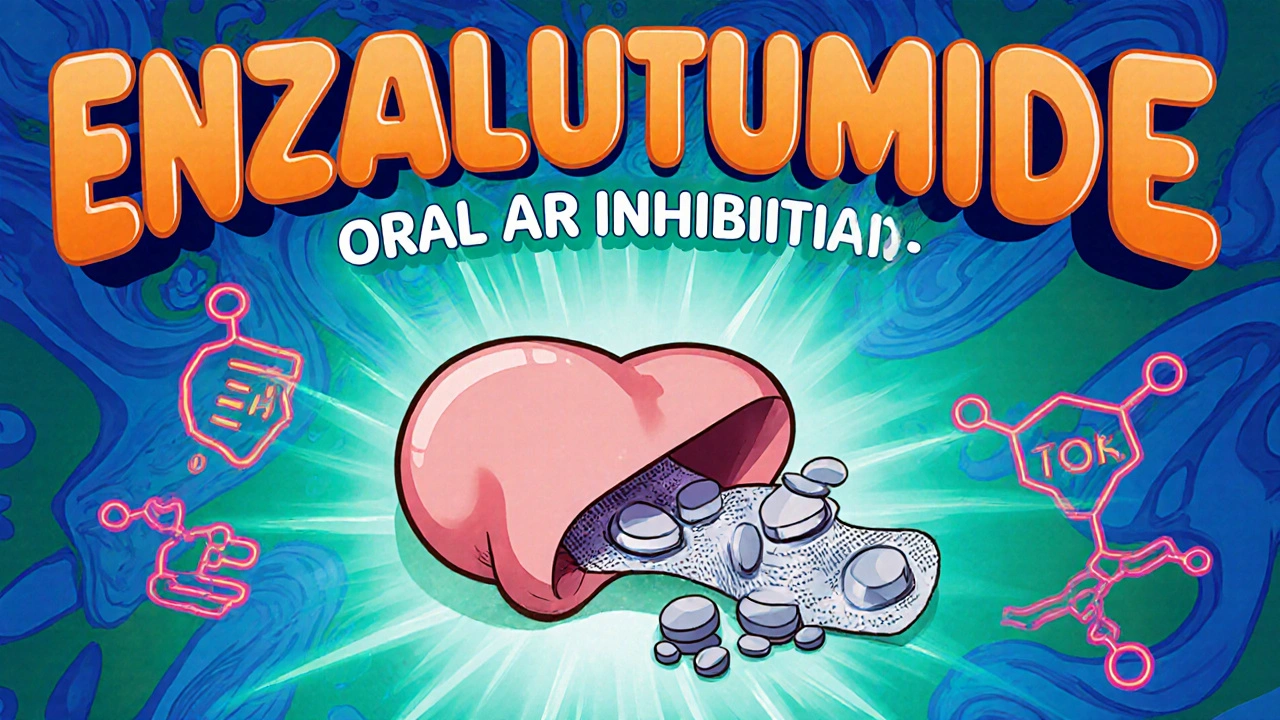Enzalutamide Drug Interaction Checker
Check Your Medications
Enter medications you're currently taking to check for potential interactions with enzalutamide.
Interaction Results
Quick Summary
- Enzalutamide is an oral androgen‑receptor inhibitor approved for metastatic castration‑resistant prostate cancer (mCRPC).
- Most concerns-fatigue, seizure risk, drug interactions-are real but manageable with proper monitoring.
- Confidence in PSA trends and imaging is justified; enzalutamide does not cause false‑positive test results.
- Resistance can develop, but switching to alternative therapies or clinical trials remains an option.
- Never stop the medication abruptly; discuss any side‑effects with your oncologist.
When a new cancer drug hits the market, patients, families, and even some clinicians end up juggling a mix of facts, rumors, and unanswered questions. Enzalutamide is an oral androgen‑receptor inhibitor used to treat prostate cancer, especially in the metastatic castration‑resistant setting. Because it’s a relatively recent addition (FDA‑approved in 2012), a lot of misinformation still circulates. This guide pulls apart the most common concerns, shows where the myths start, and offers clear, evidence‑based answers you can trust.
What Enzalutamide Actually Does
Prostate cancer growth is driven by the hormone testosterone binding to the Androgen receptor. Enzalutamide blocks that receptor in three ways: it prevents testosterone from attaching, it stops the receptor from moving into the cell nucleus, and it blocks the receptor’s ability to turn on cancer‑promoting genes. The result is slower tumor growth and, in many cases, a noticeable drop in PSA (prostate‑specific antigen) levels.
Clinical trial data-most famously the AFFIRM study-showed a median overall survival improvement of about 4.8 months versus placebo in men with mCRPC. Those numbers have held up in real‑world practice, making enzalutamide a standard‑of‑care option after androgen‑deprivation therapy fails.
Top Concerns Patients Raise
Below are the five questions that surface most often during clinic visits or online forums.
- Will I experience severe fatigue? Fatigue tops the list of reported side effects. In trial populations, about 30% of patients noted moderate to severe fatigue, but the majority manage it with lifestyle tweaks-regular light exercise, sleep hygiene, and short naps.
- Am I at risk of seizures? Enzalutamide carries a seizure warning because it can lower the seizure threshold. The absolute risk is low-roughly 0.1%‑0.2% in clinical trials-but the risk climbs for patients with a prior seizure history, brain metastases, or concomitant medications that also lower the threshold.
- Can it interact with my other drugs? Yes. Enzalutamide is metabolized mainly by the liver enzyme CYP2C8 and induces several CYP enzymes, affecting the clearance of drugs like warfarin, certain statins, and some anti‑epileptics. A thorough medication review with your pharmacist is essential.
- Will my PSA reading become unreliable? No. Enzalutamide does not artificially inflate PSA. In fact, PSA often declines as the drug takes effect, providing a reliable marker of response when paired with imaging.
- What if the cancer becomes resistant? Resistance is a real possibility, usually emerging after 12‑18 months of continuous therapy. Mechanisms include AR‑splice variants and up‑regulation of alternative growth pathways. When resistance appears, physicians may switch to chemotherapy, radium‑223, or a newer AR‑targeted agent, sometimes within a clinical trial.
Myth vs Fact Table
| Myth | Fact |
|---|---|
| Enzalutamide cures prostate cancer. | It prolongs survival and delays progression but is not curative. |
| The drug causes PSA to rise artificially. | PSA usually drops; rises signal disease progression. |
| Everyone on enzalutamide will have seizures. | Seizure risk is low and limited to high‑risk individuals. |
| It can be stopped whenever side effects appear. | Stopping abruptly may cause a rapid PSA surge; dose adjustments are preferred. |
| It has no drug‑interaction problems because it’s a pill. | Enzalutamide induces CYP enzymes, affecting many concurrent medicines. |
Practical Tips for Managing Side Effects
Knowing the "what" is only half the battle; the "how" matters more for daily life.
- Fatigue: Schedule demanding tasks for mornings, keep a consistent bedtime, and stay hydrated. Light resistance training (e.g., 15‑minute walks) can actually boost energy levels.
- Seizure vigilance: Avoid alcohol and illicit stimulants, keep a seizure‑trigger diary, and inform the oncology team if you ever feel auras or unusual visual changes.
- Blood‑test monitoring: Baseline liver function, potassium, and PSA should be checked before starting therapy, then every 4‑6 weeks for the first three months, and quarterly thereafter.
- Drug‑interaction checks: Use a medication‑tracking app or bring a full list to each visit. Common culprits include carbamazepine, phenytoin, and some antidepressants.
- When to call your doctor: New or worsening seizures, grade 3 or higher hypertension, persistent nausea, or a sudden PSA jump (>25% rise from the lowest value).

Addressing the Emotional Side of Treatment
Living with mCRPC can feel like a roller‑coaster. While the medication itself is a powerful tool, patients often need psychological support. Counseling, support groups, and mindfulness apps have shown measurable reductions in anxiety scores for men on enzalutamide. Encourage open conversations with family and consider a referral to a psycho‑oncology specialist.
Frequently Asked Questions
Can I take enzalutamide with my cholesterol medication?
Most statins are safe, but enzalutamide can increase the blood level of certain types (e.g., simvastatin). Often the doctor will switch you to rosuvastatin, which is less affected.
What should I do if I miss a dose?
Take the missed tablet as soon as you remember, unless it’s less than 12 hours until the next scheduled dose. In that case, skip the missed one and continue with your regular timing.
Is enzalutamide safe during radiation therapy?
Yes, many trials combined enzalutamide with external‑beam radiation to the prostate. Monitoring for skin irritation and fatigue is recommended, but no dose reduction is typically required.
How long will I stay on enzalutamide?
Treatment continues until disease progression, intolerable side effects, or a decision to switch therapy based on clinical judgment. Some patients remain on the drug for several years.
Does the drug affect my fertility?
Enzalutamide is not a fertility‑preserving drug. It suppresses testosterone, which can reduce sperm production. Men interested in fathering children should discuss sperm banking before starting therapy.
By separating the facts from the rumors, you can make smarter decisions about enzalutamide and stay one step ahead of the disease. Keep the dialogue open with your oncology team, follow the monitoring schedule, and remember that most concerns have practical, evidence‑backed solutions.

Margaret pope
Make sure you keep a simple sleep schedule and a short walk each day to fight the fatigue.
Emma Williams
Good points on the drug interactions.
Checking with a pharmacist is key.
Keep the medication list updated.
Stephanie Zaragoza
When considering the seizure risk associated with enzalutamide, it is essential to first review the patient’s baseline neurological status, prior seizure history, and any concomitant medications that lower the seizure threshold; this baseline assessment guides risk stratification, and it should be repeated at each follow‑up visit, especially if new agents are added to the regimen.
In clinical trials the absolute incidence of seizures was reported as 0.1‑0.2 percent, a figure that may appear negligible but becomes clinically relevant when compounded with factors such as brain metastases, electrolyte disturbances, or concurrent use of pro‑convulsant drugs, for example bupropion or certain antidepressants.
Moreover, the pharmacokinetic profile of enzalutamide includes induction of CYP3A4, which can inadvertently alter serum concentrations of co‑prescribed antiepileptics, thereby destabilising seizure control; therefore, therapeutic drug monitoring, when available, is advisable.
Patients should be counseled to avoid alcohol excess and illicit stimulants, both of which can lower the seizure threshold further, and they should be instructed to report any auras, visual disturbances, or transient loss of consciousness immediately.
It is also prudent to schedule regular laboratory assessments, including serum electrolytes and liver function tests, because hepatic impairment may increase drug exposure and amplify neurotoxic risk.
For individuals with a known seizure disorder, a neurologist’s input is recommended before initiating enzalutamide, and dose adjustment or alternative therapy should be considered if the risk outweighs the benefit.
In practice, many clinicians adopt a “watchful waiting” approach, maintaining the current dose while closely monitoring for neurologic symptoms, intervening only if warning signs emerge; this strategy balances therapeutic efficacy with safety.
Should a seizure occur, the immediate steps involve securing the airway, providing antiepileptic rescue medication, and discontinuing enzalutamide temporarily, followed by a thorough reassessment of the overall treatment plan.
Documentation of the event, including timing relative to the dose, concurrent medications, and any precipitating factors, is crucial for future decision‑making.
In the broader context of enzalutamide therapy, seizure risk, while low, exemplifies the importance of individualized care, multidisciplinary coordination, and patient education.
Finally, it is worth noting that the drug’s half‑life permits a relatively swift decline in plasma levels once stopped, which can be advantageous in managing acute adverse events, but abrupt cessation without medical supervision may precipitate a rapid PSA surge, underscoring the need for a planned taper when feasible.
All these considerations collectively form a comprehensive framework for minimizing seizure risk while preserving the oncologic benefits of enzalutamide.
James Mali
The balance between hope and caution is a delicate dance; the drug gives us a lifeline, yet we must walk the tightrope of safety without losing our footing.
Rajesh Singh
It is morally incumbent upon us to adhere to the monitoring schedule, because neglect can turn a manageable side‑effect into a preventable crisis.
Every lab draw, every PSA check, is a promise we keep to ourselves and to those who depend on us.
Albert Fernàndez Chacón
I’ve seen patients feel less alone when they know the ‘why’ behind each test.
Stay in touch with your care team and keep a simple log of side effects.
Drew Waggoner
Remember, the drug isn’t a magic bullet, but it’s a useful tool in the arsenal.
Mike Hamilton
From a cultural perspective, the shared experience of treatment can bridge gaps between patients and providers, fostering a deeper sense of community and purpose.
By embracing this journey together, we honor the humanity behind the science, even if occasionally we stumble over a typo or two.
Matthew Miller
Let’s keep the momentum going! Staying active, even with short bursts of exercise, can dramatically boost energy levels.
Celebrate each small win-whether it’s a steadier PSA trend or a brighter morning.
Liberty Moneybomb
Did you ever wonder why pharma pushes enzalutamide so hard? Some say it’s all about profit, hidden agendas, and the silent silencing of dissenting voices!
Stay vigilant, question everything, and protect your sovereignty.
Alex Lineses
Incorporating a multidisciplinary approach-oncology, pharmacy, and supportive care-optimizes therapeutic outcomes and mitigates adverse events; this collaborative model aligns with best practice guidelines.
Brian Van Horne
Adherence to scheduled monitoring remains paramount for safe enzalutamide therapy.